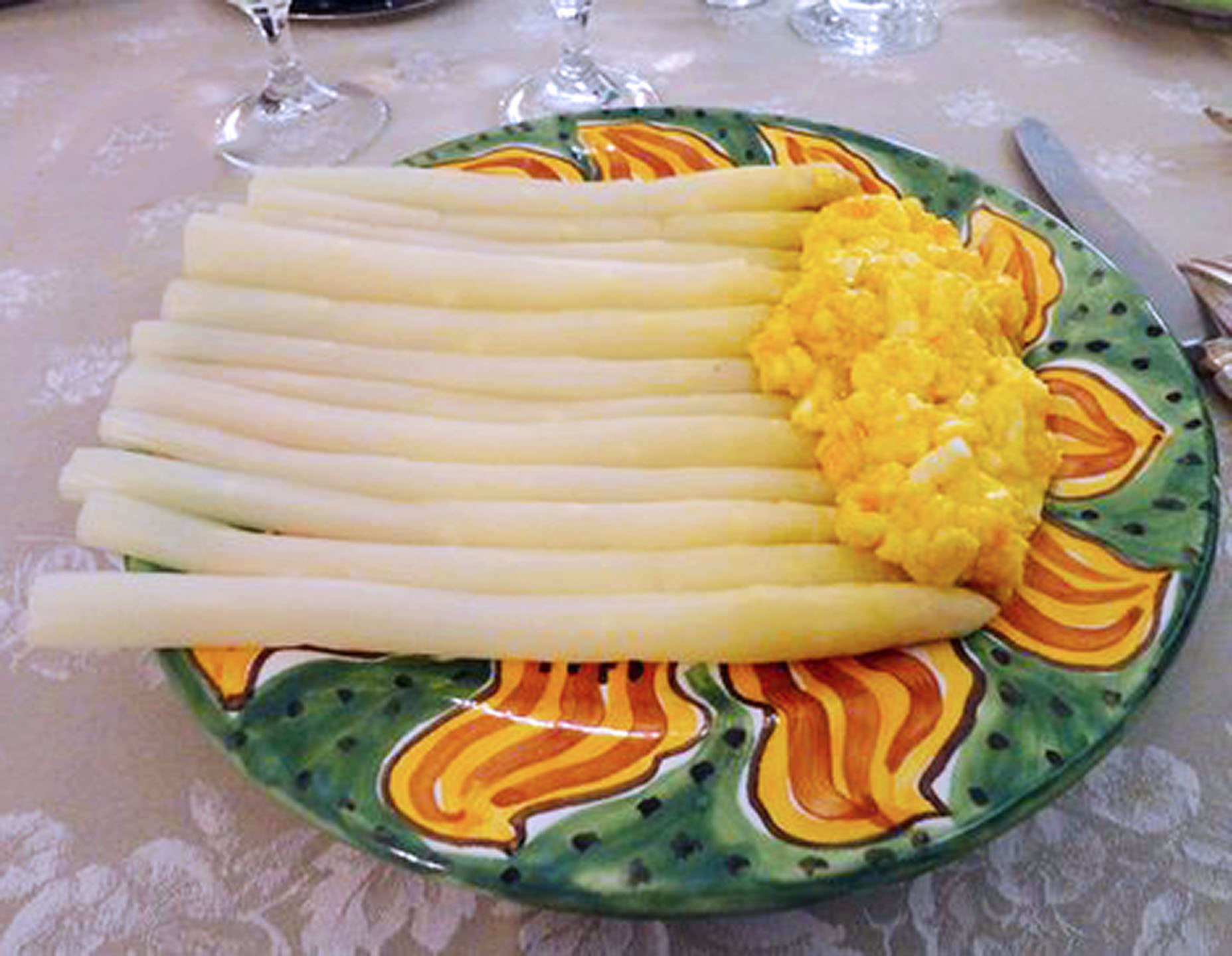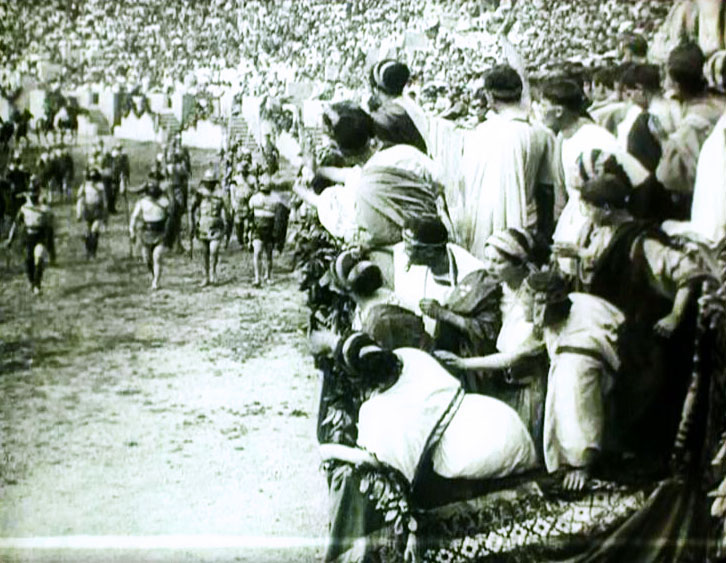While dining in Vicenza, you will encounter dishes typical of Veneto cuisine, but many others that highlight the local products that are cultivated in the fertile area south of the city. Seasonal dishes featuring local products include Risi e Bisi (risotto and peas), made with the first peas of the season, fettucine with black truffles, or mushrooms and dishes prepared with white asparagus. The best-known cheese from the province is Asiago, named after its place of origin, the Asiago Plateau, a vast mountainous territory situated in the north of the province.
There are several very good local wines from the Colli Berici DOC to enjoy with your meal, but all are rarely found outside Vicenza. If you visit the province, try Garganega from Colli Bugano, a nicely balanced white. For a red wine, try a glass of the indigenous grape, Tai Rosso that, believe it or not, is a close relation to the Sardinian Cannonau, which you can find in your local wine shop.
Asparagi di Bassano Con Salsa di Uove Sode
What is white asparagus? It is simply green asparagus that has been deprived of light, preventing it from turning green. Bassano del Grappa in the Vicenza province is famous for the asparagus. It is also home to the famous grape-based pomace brandy known as grappa and world-renowned producers of the liquor, such as Jacopo Poli and Nardini.
Ingredients
- 1 lb. asparagus, ends trimmed
- 1 oz. grappa
- 3 large eggs
- 2 tbsp. lemon juice
- ½ cup extra virgin olive oil
- 2 salt cured anchovy filets
- 1 tbsp. capers, chopped
- Kosher salt and freshly ground pepper
Preparation
Prepare three hard boiled eggs. After cooling and peeling, cut the eggs in half and remove the yolks. Debone, rinsed and chop the anchovies. After trimming the ends of the asparagus, determine whether any need to be peeled. It is sometimes the case if the skin seems thick. Tie the asparagus stalks in small bunches and stand them up in a high, narrow pan. Add water to about two-thirds up the length of the stalks and add an ounce of grappa. Simmer them until tender, about 8 minutes.
To make the sauce, breakup the hardboiled egg yolks into a small bowl. Stir in the lemon juice and slowly drizzle in the olive oil, stirring constantly. Chop the egg whites and add most of them to the sauce, reserving a bit for garnish. Add the anchovies and capers; season with salt and pepper and additional lemon juice. Arrange the asparagus and serve with the sauce. The dish is popularly served chilled as a salad, or freshly prepared, as a side dish.
Bigoli con L’Anatra
The low-lying wetlands around the Po, Brenta and Adige river valleys are a perfect breeding ground for waterfowl, which have been part of the local cuisine for hundreds of years. In Vicenza, duck ragù is served over the favorite local pasta, bigoli. The pasta is not often seen here in the U.S., but most closely resembles bucatini.
Ingredients
- 1 tbsp. extra-virgin olive oil
- 1 duck, cut into quarters
- coarse salt and freshly ground black pepper
- 2 celery stalks, peeled and finely chopped
- 1 small yellow onion, finely chopped
- 1 carrot, finely chopped
- 2 cloves garlic, peeled and crushed
- ½ cup white wine
- 1 cup chicken broth
- 3 tbsp. tomato paste
- 1 tbsp. chopped fresh sage
- 1 tbsp. chopped fresh rosemary
- 1 lb. fresh bigoli pasta (or bucatini)
- freshly grated Grana Padana cheese, for serving (optional)
Preparation
Heat the oil heavy-duty pot over medium-high heat. Season the duck pieces with salt and pepper and place into the pot, skin side down. Sear until the skin is browned and crisp, about 7 minutes. Turn the pieces over and brown for 2 to 3 minutes. Remove the duck and pour off all but about 1 tablespoon of the rendered fat.
Reduce the heat to medium low. Place the celery, onion and carrot into the pot. Cook, stirring frequently, until the vegetables have softened, 7 to 8 minutes. Add the garlic and cook until aromatic, about 1 minute.
Pour in the wine and increase the heat to high. Boil until wine is reduced by half, then reduce the heat to medium. Add the broth, tomato paste, sage and rosemary, stirring to combine. Return the duck to the pot and bring the liquid to a boil. Reduce the heat to low, just enough to maintain a gentle simmer. Cover the pot and simmer until the meat is fork-tender, 1 ½ to 2 hours.
Remove the duck from the pot and set aside until cool enough to handle. Meanwhile, skim the excess fat from the top of the sauce with a large spoon. If the sauce seems thin, continue simmering until thickened to desired consistency.
Discard the duck skin and shred the meat. Add the shredded meat to the sauce. Let the sauce simmer gently for 15 minutes. Season to taste with salt and pepper.
When ready to serve, bring a large pot of salted water to a boil over high heat. Cook the pasta until al dente. Reserve about 1 cup of the cooking water and then drain the pasta. Return the pasta to the pot and toss it with some of the ragù, adding a little cooking water if it seems dry. Serve the pasta with more ragù spooned over the top, garnished with freshly grated Grana cheese.
Fegato alla Veneziana
Venetian liver and onions is hugely popular throughout the Veneto region. It couples thinly sliced liver with an abundance of well-caramelized onions, which adds sweetness to balance the liver’s earthy flavor. White wine, or vinegar is used in the recipe to tone down the sweetness of the onion and to add depth and character to the dish.
Ingredients
- 1 lb. calves liver
- 1 lb. onion, thinly sliced
- ½ cup olive oil
- 2 tbsp. butter
- a few sprigs of fresh parsley, finely chopped
- salt and pepper
- ½ cup white wine
Preparation
Begin by sautéing thinly sliced onion in a combination of butter with 2 tablespoons of olive oil over medium flame in a wide skillet until the onions are very soft. The onion should not color, so turn the flame to low shortly after adding the onions to the pan. Adding a bit of the white wine will help the onions to wilt and prevent browning.
When the onions are ready, push to the edges of the skillet. Add a bit more olive oil and raise the flame to medium-high and add sliced calf’s liver, trimmed and sliced into thin strips, to the skillet. Sauté until the liver has lost its raw color. Mix the onions and liver well, adding a handful of finely chopped parsley and season well with salt and pepper. After a minute or so, remove the liver and onions to a warm serving plate.
Add the white wine to the skillet and deglaze, scraping up the bits that will have formed with a wooden spoon or spatula. When the wine has reduced to a syrupy consistency, pour it over liver, with some additional chopped parsley and serve immediately.





